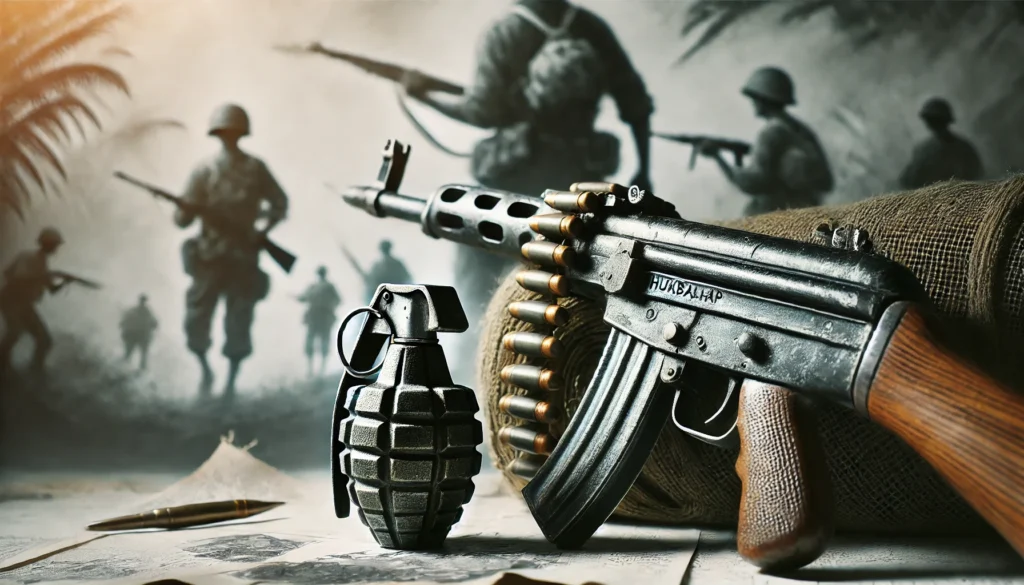The roots of the Hukbalahap Rebellion can be traced back to the agrarian unrest that plagued the Philippines in the pre-World War II era. The Philippine countryside, particularly in Central Luzon, was characterized by a feudal-like system where a small number of wealthy landowners controlled vast tracts of land. This system, known as hacienda, left the majority of farmers as tenants with little to no land ownership. The disparity in land distribution led to widespread poverty and discontent among the peasantry, setting the stage for future conflicts.
Formation of the Hukbalahap
The Hukbalahap, short for Hukbo ng Bayan Laban sa Hapon (People’s Army Against the Japanese), was formed on March 29, 1942, in the wake of the Japanese occupation of the Philippines. Initially, the organization was established as a guerrilla resistance movement against the Japanese invaders. Led by Luis Taruc and other communist leaders, the Hukbalahap quickly gained support among the peasants in Central Luzon, who saw it as a means to fight both foreign occupation and local oppression.
The Hukbalahap During World War II
Resistance Activities
During World War II, the Hukbalahap played a significant role in the resistance against Japanese occupation. Their activities included:
- Sabotaging Japanese military operations
- Gathering intelligence for Allied forces
- Protecting local communities from Japanese atrocities
- Maintaining a semblance of local governance in areas under their control
The Hukbalahap’s effectiveness in guerrilla warfare earned them respect among the local population and recognition from some American military officials.
Ideological Foundations
While the immediate goal of the Hukbalahap was to resist Japanese occupation, its leadership, influenced by communist ideology, had broader aspirations. They envisioned a post-war Philippines with significant land reform and social changes. This ideological underpinning would later play a crucial role in shaping the movement’s actions after World War II.
Post-War Disarmament and Tensions
Disarmament Controversy
Following the liberation of the Philippines in 1945, tensions quickly arose between the Hukbalahap and the newly established Philippine government, supported by the United States. The government, wary of the Hukbalahap’s communist leanings and military capabilities, sought to disarm the group. This move was met with resistance from Huk members who felt they deserved recognition for their wartime efforts and were suspicious of the government’s intentions.
Political Repression
The post-war period saw increasing political repression against Hukbalahap members and suspected sympathizers. Key events included:
- Arrest of Huk leaders, including Luis Taruc
- Disenfranchisement of Huk-dominated areas in the 1946 elections
- Violent clashes between government forces and Huk members
These actions further alienated the Hukbalahap from the government and pushed the movement towards open rebellion.
The Rebellion Takes Shape
Transition to Armed Struggle
By 1946, the Hukbalahap had transformed from a wartime resistance movement into a full-fledged rebellion against the Philippine government. The group renamed itself Hukbong Mapagpalaya ng Bayan (HMB) or People’s Liberation Army, signaling its shift towards a communist-inspired revolution.
Objectives of the Rebellion
The Hukbalahap Rebellion had several key objectives:
- Land reform and redistribution
- Improved rights and conditions for peasants and workers
- Removal of U.S. influence in Philippine affairs
- Establishment of a communist government
These goals resonated with many in the rural areas who felt marginalized by the existing political and economic system.
Military Operations and Tactics
Guerrilla Warfare
The Huks employed guerrilla tactics similar to those used during the Japanese occupation. Their strategy included:
- Ambushes on government forces
- Hit-and-run attacks on military installations
- Establishing base areas in remote, forested regions
- Mobilizing peasant support through propaganda and social programs
Government Counter-insurgency
The Philippine government, with U.S. support, launched extensive counter-insurgency operations. These included:
- Large-scale military offensives in Huk-controlled areas
- Intelligence gathering and infiltration of Huk networks
- Psychological warfare campaigns
- Economic and social reform programs to win “hearts and minds”
The effectiveness of these operations varied, with initial government efforts often hampered by corruption and poor strategy.
Peak of the Rebellion
Expansion and Control
At its height in the late 1940s and early 1950s, the Hukbalahap Rebellion posed a serious threat to the Philippine government. The movement:
- Controlled significant portions of Central Luzon
- Had an estimated 10,000-15,000 armed fighters
- Enjoyed support from a much larger number of civilian sympathizers
The rebellion’s strength forced the government to divert substantial resources to combat the insurgency, impacting the country’s post-war recovery efforts.
Impact on Philippine Society
The rebellion had far-reaching effects on Philippine society:
- Intensified political polarization
- Disrupted economic activities in affected areas
- Prompted debates on land reform and social inequality
- Influenced U.S.-Philippines relations and Cold War dynamics in Southeast Asia
Key Figures in the Conflict
Hukbalahap Leadership
| Name | Role | Significance |
|---|---|---|
| Luis Taruc | Founder and Supreme Leader | Charismatic leader who became the face of the rebellion |
| Jesus Lava | General Secretary of the Communist Party | Provided ideological direction to the movement |
| Casto Alejandrino | Military Commander | Led many of the Huks’ military operations |
Government and Military Figures
| Name | Position | Contribution |
|---|---|---|
| Ramon Magsaysay | Secretary of National Defense (later President) | Spearheaded effective counter-insurgency efforts |
| Edward Lansdale | U.S. Air Force Officer | Advised on psychological warfare tactics |
| Cornelio Villareal | Congressman | Advocated for amnesty and reconciliation policies |
Decline of the Rebellion
Factors Contributing to Decline
Several factors led to the weakening of the Hukbalahap Rebellion in the mid-1950s:
- Improved Government Strategy: Under Ramon Magsaysay, the government implemented more effective military and social programs to combat the insurgency.
- Internal Divisions: Ideological disputes and leadership conflicts weakened the Huk movement from within.
- Loss of Popular Support: As the government addressed some grievances and improved its image, public backing for the rebellion waned.
- International Context: The global Cold War climate made it difficult for the communist-affiliated Huks to gain external support.
Surrender of Key Leaders
The surrender of prominent Huk leaders dealt significant blows to the rebellion:
- Luis Taruc surrendered in 1954, marking a symbolic end to the movement’s peak.
- Other leaders followed suit or were captured in subsequent years.
While these surrenders didn’t completely end the insurgency, they greatly reduced its scale and threat to the government.
Land Reform and Social Changes
Government Initiatives
In response to the rebellion, the Philippine government initiated several land reform and social welfare programs:
- The Agricultural Tenancy Act of 1954
- The Land Reform Code of 1955
- Resettlement programs for landless farmers
These measures, while limited in scope, represented attempts to address some of the root causes of the rebellion.
Long-term Impact
The Hukbalahap Rebellion had a lasting impact on Philippine land reform policies:
- It highlighted the urgency of addressing agrarian issues.
- Subsequent administrations continued to grapple with land reform, leading to more comprehensive programs in later decades.
- The rebellion influenced political discourse on social inequality and rural development.
Legacy of the Hukbalahap Rebellion
Political and Social Implications
The Hukbalahap Rebellion left a complex legacy in Philippine history:
- It exposed deep-seated social and economic inequalities in Philippine society.
- The rebellion influenced the development of both leftist movements and anti-communist policies in the Philippines.
- It shaped the Philippine government’s approach to counter-insurgency and rural development.
Cultural Impact
The rebellion has been memorialized in various forms of Philippine culture:
- Literature: Novels and poems depicting the struggle of the Huks
- Cinema: Films exploring the themes of peasant uprising and social justice
- Historical memory: Debates over the portrayal of the Huks in national history
Lessons and Continuing Relevance
Agrarian Reform Lessons
The Hukbalahap Rebellion underscored several key lessons regarding agrarian reform:
- The importance of addressing rural poverty and land inequality
- The need for comprehensive approaches combining economic, social, and political reforms
- The challenges of implementing effective land redistribution programs
Contemporary Echoes
Elements of the issues raised by the Hukbalahap Rebellion continue to resonate in modern Philippines:
- Ongoing debates over land reform and rural development
- The persistence of communist insurgency in some parts of the country
- Discussions about social inequality and political representation of marginalized groups
Scholarly Perspectives and Debates
Historiographical Trends
Historical interpretation of the Hukbalahap Rebellion has evolved over time:
- Early accounts often portrayed the rebellion primarily as a communist insurgency.
- Later scholarship has emphasized the social and economic roots of the movement.
- Recent studies have explored the complexities of local experiences and the rebellion’s place in global Cold War dynamics.
Debates Among Historians
Key points of debate among scholars include:
- The extent of communist ideology’s influence on the movement
- The effectiveness and intentions of government counter-insurgency measures
- The long-term impact of the rebellion on Philippine politics and society
These ongoing discussions reflect the complexity and continued relevance of the Hukbalahap Rebellion in Philippine historiography.
Conclusion: The Hukbalahap Rebellion’s Place in Philippine History
The Hukbalahap Rebellion stands as a pivotal event in 20th-century Philippine history. It emerged from the crucible of World War II resistance, evolved into a significant challenge to the post-war Philippine state, and ultimately shaped debates on land reform, social justice, and national development that continue to this day. While the armed struggle has long since ended, the issues it raised about equality, land ownership, and rural development remain relevant in contemporary Philippine society. The rebellion’s legacy serves as a reminder of the complex interplay between social grievances, political ideologies, and the challenges of nation-building in the post-colonial era.
Disclaimer: This article aims to provide an accurate and comprehensive overview of the Hukbalahap Rebellion based on historical research up to 2023. However, historical interpretations can evolve with new evidence and scholarship. Readers are encouraged to report any inaccuracies or new information for prompt review and update. For the most current research on this topic, please consult recent academic publications and reputable historical sources.




